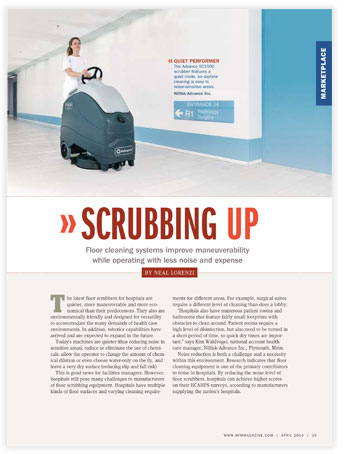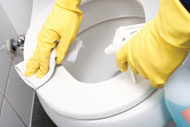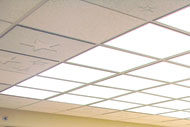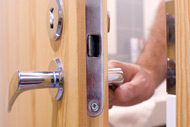 The latest floor scrubbers for hospitals are quieter, more maneuverable and more economical than their predecessors. They also are environmentally friendly and designed for versatility to accommodate the many demands of health care environments. In addition, robotics capabilities have arrived and are expected to expand in the future.
The latest floor scrubbers for hospitals are quieter, more maneuverable and more economical than their predecessors. They also are environmentally friendly and designed for versatility to accommodate the many demands of health care environments. In addition, robotics capabilities have arrived and are expected to expand in the future.
Today's machines are quieter (thus reducing noise in sensitive areas), reduce or eliminate the use of chemicals, allow the operator to change the amount of chemical dilution or even choose water-only on the fly, and leave a very dry surface (reducing slip and fall risk).
This is good news for facilities managers. However, hospitals still pose many challenges to manufacturers of floor scrubbing equipment. Hospitals have multiple kinds of floor surfaces and varying cleaning requirements for different areas. For example, surgical suites require a different level of cleaning than does a lobby.
"Hospitals also have numerous patient rooms and bathrooms that feature fairly small footprints with obstacles to clean around. Patient rooms require a high level of disinfection, but also need to be turned in a short period of time, so quick dry times are important," says Kim Waldvogel, national account health care manager, Nilfisk-Advance Inc., Plymouth, Minn.
Noise reduction is both a challenge and a necessity within this environment. Research indicates that floor cleaning equipment is one of the primary contributors to noise in hospitals. By reducing the noise level of floor scrubbers, hospitals can achieve higher scores on their HCAHPS surveys, according to manufacturers supplying the nation's hospitals.
Standing or sitting
Rider machines are often the best choice because they reduce operator fatigue and increase productivity, experts agree; however, walk-behind units still have their place in hospitals.
The decision to go with either a walk-behind or rider machine should be based on square footage cleaning requirements divided by the hours available to clean an area, according to Rex Shull, product manager at Kärcher North America, Englewood, Colo. "Cleaning equipment makes up 2 to 8 percent of an environmental services budget while labor makes up 65 to 90 percent, depending on the size of the facility. The right size equipment will always have a reasonable payback when all aspects are considered," he says.
Beyond increased productivity, safety is an often-overlooked benefit of rider floor scrubbing equipment, says Paul Lewandowski, product manager at Betco Corp., Toledo, Ohio. "On riding equipment, the operator is typically forward or centrally located on the machine," he notes. "When approaching a blind corner or the entrance to a patient room, the operator can easily see an approaching obstacle or hazard. When using a walk-behind, the operator is at the rear of the machine. So, when approaching a blind obstacle or doorway, the machine usually is the first to encounter the hazard before the operator has a chance to see it."
Essential wish list
What other factors should hospital facilities managers consider when selecting and buying floor cleaning equipment? Carolyn Cooke, vice president, North America health care sector , Diversey Care, Sturtevant, Wis., says they should ask the following questions:
- Is the machine cost-effective and can it provide labor savings?
- Does it allow easy changing of cleaning solutions and minimize downtime for refills?
- From an ergonomic perspective, how long can staff use the equipment before getting tired?
- What is the noise level of the auto scrubber?
- Does the machine offer easy repair and a cost-effective maintenance program?
- Does it offer battery management technology that increases battery life?
- Does the equipment meet the facility's environmental and sustainability requirements?
Manufacturers have answered many of these challenges. "Equipment that is small, maneuverable and has noise-dampening components to drive down decibels is increasingly being used to clean patient rooms as well as hallways within hospitals," says Chris Wetmore, director of health care and BSC, Tennant Co., Minneapolis. "Also, new technology is available that can reduce the use of conventional cleaning chemicals, reducing exposure to volatile organic compounds and fragrances for patients who may have chemical sensitivities."
Floor scrubber manufacturers are striving to decrease noise levels by reducing vacuum and brush speeds as well as adding insulation, according to Kärcher North America's Shull. Many manufacturers have achieved noise levels in the mid-60-decibel range, which is an improvement but still not the ultimate goal.
Floor scrubbers are being built for quieter operation, while addressing the issue of the high cost of maintenance and budget cuts that all hospitals must contend with, agrees Erick Frack, president, Intellibot Robotics, Portland, Ore. "Floor scrubbing machines are being introduced that reduce cleaning costs, and include an advanced water-purification system as well as a UV light that helps to eliminate bacteria."
New developments
Nilfisk-Advance Inc. recently introduced the Advance brand SC1500 Stand-on Scrubber, which features a 12-gallon-tank capacity and 3.5 hours of battery runtime. The machine incorporates a one-touch scrub on/off switch and intuitive dashboard controls. Sustainable cleaning is achieved with an onboard EcoFlex System, which allows the operator to switch between chemical-free cleaning and select from weak to strong cleaning intensities, according to Waldvogel.
Nilfisk-Advance also has introduced the Clarke brand Focus II MicroRider. Its compact size, easily maneuverable design and wide cleaning path allow the operator to clean a variety of areas ranging from tight, space-restricted applications to larger cleaning spaces.
Using a manually powered pump, the Kärcher B 60/10 eco! cleans floors and leaves them dry while operating at a noise level of 52 decibels. "In a recent study, the unit was running at a hospital and, when the nursing staff were questioned about the noise level, most didn't realize the machine was running," says Shull. "It also uses continuous clean water to clean and recover contaminated water. This prevents the solution from coming into contact with the operator."
Todd Hunsucker, vice president, business development, TASKI by Diversey, says his company has developed a floor-cleaning dosing and delivery system that ensures optimal water and chemical usage, thus reducing consumption. Solution-application intelligence on floor-cleaning equipment enables auto scrubbers to apply the right amount of cleaning solution, at variable rates based on the operator's speed, to provide maximum cleaning efficiency and soil pickup while leaving a floor almost dry.
"Called the TASKI IntelliFlow, the system delivers the proper amount of cleaning solution and water onto the floor, according to the speed of the machine. As the operator slows down, the system adjusts in real time to use less solution — substantially decreasing water consumption, reducing time-consuming tank fills, and lowering costs and waste," Hunsucker explains.
Intellibot Robotics' Hands-Free Cleaning HydroBot scrubber can operate without constant attention from staff, according to Frack. "It has a five-stage water filtration system that purifies water to 1 micron. It also uses UV light that reduces bacteria by 99.9 percent, reduces wastewater and chemical use by 85 percent and enables cleaning staff to 'turn' rooms more quickly. As a result, they are able to focus on higher-level cleaning activities while the robot cleans floors, thus improving the hospital's bottom line," he says.
Floor scrubbers equipped with Tennant Co.'s ec-H2O technology leave no chemical residue behind, so floors retain a polished look and require only simplified, ongoing maintenance, says Wetmore. "Scrubbers using ec-H2O can scrub up to three times longer with a single tank of water and use up to 70 percent less water than conventional floor scrubbing methods," he notes.
Orbio Technologies, a Tennant Co. Group, recently introduced On-Site Generation products that produce ready-to-use cleaning solution at health care facilities. The group also launched the Orbio 5000-Sc, which generates a no-VOC, no-fragrance cleaning solution for floors outside critical care areas.
Betco introduced the Stealth DRS21BT MicroRider Scrubber, which operates at 54 decibels. The machine is designed with the same footprint as a standard 20-inch, walk-behind scrubber, yet is capable of cleaning up to 30,000 square feet per hour and includes 50 percent larger solution tanks.
Betco's Lewandowski sees a hospital trend toward installation of more luxury vinyl tiles that are manufactured to look like other natural surfaces such as wood, stone or tile. This type of tile has a certain degree of texture to it — a raised wood grain or a natural stone appearance. Traditional rotary scrubbers are not suitable for cleaning these surfaces, he says.
"Betco's Stealth line of automatic scrubbers includes two new cylindrical models designed to clean these textured surfaces," he says. "The machines are equipped with high-speed cylindrical brushes that clean into the grooves and textures of these tiles."
Upcoming advances
Longer battery life, better air filtration, recycling of water, fewer moving parts and machines that can be used for multiple tasks are among many upcoming advances in floor scrubbing equipment, according to William R. Griffin, president of Cleaning Consultant Services Inc., Seattle. He also predicts more options for component repairs, automated and online wireless diagnostics, and robotics in the near future.
Robotics is definitely on the way as equipment becomes more sophisticated, he says. "It's only a matter of time before automated equipment replaces humans for mundane tasks," Griffin notes. "Within the next 15 years, cleaning technicians will oversee multiple robots that handle basic cleaning tasks. The problem today relates to distribution roadblocks and a lack of qualified support systems to set up and service this type of equipment."
The evolution of mechanized equipment both in and out of health care would foretell that robotic solutions are on the way, says Wetmore. "However, I believe we have a long way to go before effective robotic solutions that also are cost-efficient will be introduced to the health care environment," he says. "This topic will gain momentum within the cleaning equipment industry in the near future."
Neal Lorenzi is a freelance writer based in Mundelein, Ill.
For more information
For further details on the floor scrubbing equipment featured in this month's Marketplace article, contact the following vendors:
» Betco Corp.
www.betco.com
» Diversey Care
www.taskibydiversey.com
» Intellibot Robotics
www.intellibotrobotics.com
» Kärcher North America
www.karchercommercial.com
» Nilfisk-Advance Inc.'s Advance brand
www.advance-us.com
» Nilfisk-Advance Inc.'s Clarke brand
www.clarkeus.com
» Tennant Co.
www.tennantco.com





